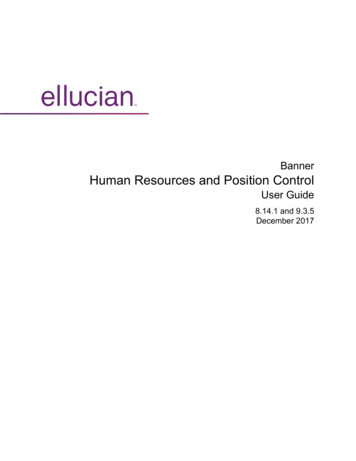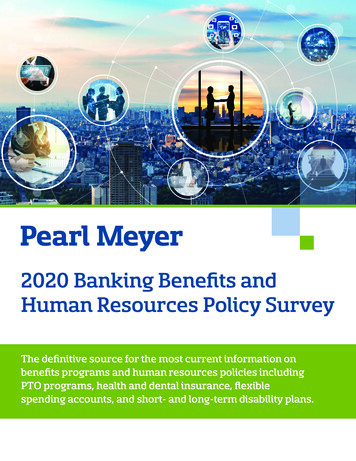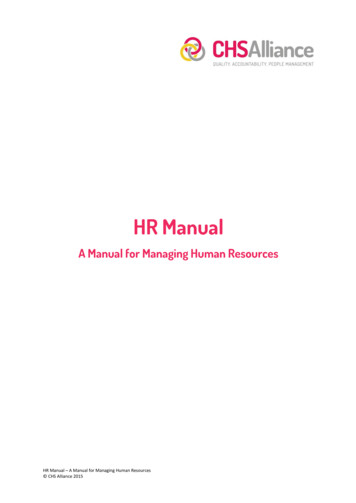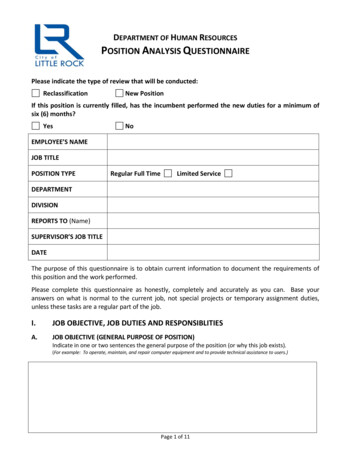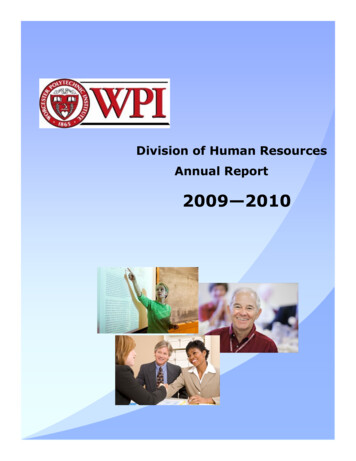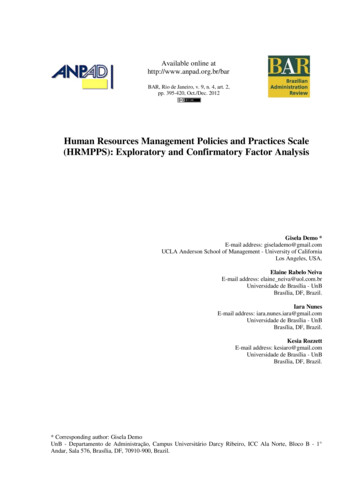
Transcription
Available online athttp://www.anpad.org.br/barBAR, Rio de Janeiro, v. 9, n. 4, art. 2,pp. 395-420, Oct./Dec. 2012Human Resources Management Policies and Practices Scale(HRMPPS): Exploratory and Confirmatory Factor AnalysisGisela Demo *E-mail address: giselademo@gmail.comUCLA Anderson School of Management - University of CaliforniaLos Angeles, USA.Elaine Rabelo NeivaE-mail address: elaine neiva@uol.com.brUniversidade de Brasília - UnBBrasília, DF, Brazil.Iara NunesE-mail address: iara.nunes.iara@gmail.comUniversidade de Brasília - UnBBrasília, DF, Brazil.Kesia RozzettE-mail address: kesiaro@gmail.comUniversidade de Brasília - UnBBrasília, DF, Brazil.* Corresponding author: Gisela DemoUnB - Departamento de Administração, Campus Universitário Darcy Ribeiro, ICC Ala Norte, Bloco B - 1 Andar, Sala 576, Brasília, DF, 70910-900, Brazil.
G. Demo, E. R. Neiva, I. Nunes, K. Rozzett396AbstractGiven the strategic relevance of Human Resources Management (HRM) in organizations and the lack ofscientific instruments to measure employees’ perceptions about policies and practices of HRM, this study aimedto validate the Human Resources Management Policies and Practices Scale (HRMPPS) through exploratory andconfirmatory factor analysis using the maximum likelihood method. The study has a quantitative design, but alsoincluded qualitative analysis required for the development of a scale. Employees from various organizationscomposed a sample of 632 people. Scale reliability was assessed by Cronbach’s alpha and Jöreskog’s rho. A sixfactor model was generated showing high-reliability and good fit. Construct validity was provided throughconvergent and discriminant analyses. The factors were consistent with the literature review and explained about58% of the construct’s total variance. This study contributes to the scientific production in the area of HumanResources Management since HRMPPS can be used not only in relational studies but also as an evaluationinstrument by managers who wish to improve their employees’ well-being as well as organizational outcomes.Key words: human resources policies; exploratory factor analysis; confirmatory factor analysis; structuralequation modeling.BAR, Rio de Janeiro, v. 9, n. 4, art. 2, pp. 395-420, Oct./Dec. 2012www.anpad.org.br/bar
Human Resources Management Policies and Practices Scale397IntroductionGiven the strategic relevance of Human Resources Management (HRM) in organizations andthe lack of scientific instruments to measure employees’ perceptions about policies and practices ofHRM, the objective of this study is to develop and validate a Human Resource Management Policiesand Practices Scale, called HRMPPS.According to Huselid (1995), work on the measurement of HRM policies and practices isextremely limited and this is still true today. Besides some indexes of HRM practices identified byadvocates of the high commitment approach (Guest, 1998; Pfeffer, 2005), the only scales found in theliterature were the High-Performance Work Practices developed and validated by Huselid (1995), with13 items and a .67 Cronbach’s alpha, and the Perception of Personnel Management Policies Scale(PPMPS), developed and validated by Demo (2008), with 19 items distributed across 4 factors andpresenting Cronbach’s alpha above .70.The PPMPS includes only four HRM policies: involvement; training, development andeducation; work conditions; and compensation and rewards. Considering the shortage of scientificvalidated scales to measure employee’s perceptions about HRM policies, the PPMPS is a good optionto be used so far (e.g. Rubino, Demo, & Traldi, 2011). However comprehensive instruments withhigher reliability for measuring HRM policies and practices are demanded.Thereafter, this paper attempted to answer the following question: is it possible to develop andvalidate a comprehensive and highly-reliable scale, validated through both exploratory andconfirmatory factor analysis?The HRMPPS presented here sought to improve the completeness and the scope of the previousscales validated in the literature by adding policies for recruitment and selection, competency-basedperformance appraisal, also often cited by classic authors of the area, such as Bohlander and Snell(2009), Dessler (2002), Guest (1987), Sisson (1994) and Storey (1995).Furthermore, if the HRMPPS presents good psychometric parameters, remaining stable in othersamples, it would be a reliable and more comprehensive instrument than the existing ones for use inrelational studies in the Human Resources, Management and Organizations fields. Additionally, it canbe used in managerial practice as well, as a diagnosis to improve employee’s well-being at work andoptimize organizational results.First, a literature review is presented about human resources management, its strategic role inorganizations, and human resources management policies, including their constitutive definitions. Themethods used are then described, detailing the procedures to develop the scale, the exploratoryvalidation, the validation in a different sample in order to test the scale generalizability and theconfirmatory factor validation through structural equation modeling. Construct validity is providedthrough convergent and discriminant analysis. Finally, the results are presented and discussed andconclusions are made, focusing on the study contributions and proposal of a research agenda.Theoretical BackgroundMany authors understand HRM’s current role in the organizations as being strategic. One of thedistinctive features of HRM is that better performance is achieved through the people in theorganization (AlDamoe, Yazam, & Ahmid, 2012). Ulrich, Halbrook, Meder, Stuchlik, and Thorpe(1991) stated that the competitive panorama is constantly being changed and has been demanding newmodels of competitiveness which in turn require organizational capacities that will enable thecompanies to better serve their customers and distinguish them from their competitors. TheseBAR, Rio de Janeiro, v. 9, n. 4, art. 2, pp. 395-420, Oct./Dec. 2012www.anpad.org.br/bar
G. Demo, E. R. Neiva, I. Nunes, K. Rozzett398organizational capacities come from the redefinition and redistribution of HRM practices, functionsand professionals.By summarizing what authors such as Guest (1987), Storey (1995), Legge (2006) andBohlander and Snell (2009) say, it is possible to observe that people have been assuming a strategicand relevant role in organizations, and therefore cohesive and coherent theories - aligned to bothplanning and organizational strategy - must properly sustain HRM.In this meaning, HRM policies and practices may vary among organizations and should bealigned with business strategy (Chênevert & Tremblay, 2009). Boxall and Purcell (2000) add that theeffects of individual HRM practices depend on both the nature of the effects of other HRM practicesand the business strategy. Also, Lim (2012) argues that external business environment has a stronginfluence on HRM activities.From the perspective of Strategic HRM, policies and practices can be mutually reinforced andcreate a strong impact on organizational goals (Morris & Snell, 2010). Moreover, HRM policies areguided by the logic of skills developed in accordance to the requirements of business processes(Serpell & Ferrada, 2007). Thus, they provide tools to capture and communicate the strategic visionand objectives of the organization in clear terms that can be more easily understood and requested(Vakola, Soderquist, & Pratascos, 2007).Within this context, the development of scales that allow an estimation of the perception ofHRM policies aims to identify to what extent they are applicable to various organizations and alignedwith an organization’s strategy. In addition, a scale can translate how HRM policies are associatedwith business strategy, because only then can they be effective (Legge, 2006).HRM must also not be relegated to a traditional supporting role anymore, but instead mustconstitute an essential competence in reaching the organizational and individual objectives and results,since human resources are valuable and constitute a source of competitive advantage. Uysal (2012)indeed found strong, positive and significant correlations among the main HRM policies cited in theliterature, such as staffing, training, performance evaluation and compensation. These results areimportant for understanding the inter-relationships between HRM practices in order to enhance theeffect HR systems have on employee-based organizational outcomes.In this context, organizations have turned to the perspective of creating competitive advantage.Consequently, themes related to the areas of organizational strategy and theory converge, spawningcomprehensive implications for HRM and putting its primary function under discussion. According tothe Resourced Based View by Barney (1991), the creation of competitive advantage depends onprerequisites that may be closely related to the HRM area, since resources must be valuable and rare tothe organization, may never be imitated or replaced, and the organization must be able to exploit them.Beauvallet and Houy (2010) support that the key mechanism and decisive variable that would justifythe competitive advantages of companies alleged as being lean enterprises, or the ones practicing alean management, are directly related to HRM.The term organizational policy can be defined as: principles established for leading a company,a general course of action in which some practices are developed collectively, in a constructive way,aiming to reach certain objectives (Singar & Ramsden, 1972). HRM policies define the attitude,expectations and values of the organization concerning how individuals are treated, and still serve aspoint of reference for the development of organizational practices and for decisions made by people,besides resulting in equal treatment among individuals (Armstrong, 2009).In this study the term HRM policy means an organizationally articulated proposal, withtheoretical and practical constructions within human relations aiming to reach the desired results.Thereby, HRM policies define theoretical and practical referential built to make possible the reachingof an organization’s objectives and purposes, operating as thinking and acting guides for the HRMarea.BAR, Rio de Janeiro, v. 9, n. 4, art. 2, pp. 395-420, Oct./Dec. 2012www.anpad.org.br/bar
Human Resources Management Policies and Practices Scale399Some research results have pointed out positives relationships between HRM policies andvariables like commitment, productivity, profitability and quality, among others (Guest, 1987;Schneider & Bowen, 1985; Ulrich, Halbrook, Meder, Stuchlik, & Thorpe, 1991). In the meta-analysisperformed, Combs, Liu, Hall, and Ketchen (2006), found that relationships between Human Resourcespractices and organizational outcomes are stronger in manufacturing companies than in servicecompanies.Studies have also been conducted in cultures other than the American and European ones.Majumder (2012) verified strong relationships between HRM practices and employee satisfaction inBangladeshi private banks, and Kim and Lee (2012) found evidence that HRM policies and practicesimprove strategic capabilities and firm performance in management consultant firms in South Korea.The study by Demo (2010) showed positive and strong relationship between HRM policies andorganizational justice in both private and public Brazilian organizations.Similarly, other researches have shown that HRM policies and practices favorably affectorganizational performance (Boselie, Dietz, & Boon, 2005; Menezes, Wood, & Geladi, 2010;Subramony, 2009). Guest and Conway (2011) confirmed the association between both more HRMpractices and higher HR effectiveness and a range of performance outcomes.Besides, ALDamoe, Yazam and Ahmid (2012) concluded that employee retention is likely tomediate in the relationship between HRM practices and organizational performance. Employeeperceptions of HRM policies and practices also influence discretionary work effort and co-workerassistance (Frenkel, Restubog, & Bednall, 2012). On the other hand, the effectiveness and acceptanceof HRM policies are related to organizational values and culture (Stone, Stone-Romero, &Lukaszewski, 2007).There is indeed a consensus that HRM practices produce higher organizational performancewhen integrated into business strategy (Ezzamel, Lilley, & Willmott, 1996; Guest & Hoque, 1994).This is also true for small firms. The study conducted by Katou (2012) showed that HRM policieshave a positive effect on organizational performance through employee attitudes (satisfaction,commitment, motivation) and employee behaviors (absences, turnover, disputes).In summary, HRM policies assume special connotation in development, appreciation andretention of talents. They also promote employee commitment and, as a result, goodwill on their partto act in a flexible and adaptive manner towards excellence in organizations (Legge, 2006). Anentrepreneurial strategy aiming at production and supply of added-value products and services mustconcern the development and the implementation of HRM policies resulting in well-qualifiedemployees (Legge, 2006).Table 1 summarizes the selected policies as well as constitutive definitions elaborated from theliterature review. The main authors who were reviewed in the development of the theoreticalbackground for each HRM policy are pointed out.Table 1Constitutive Definitions of HRM Policies and Their Theoretical BackgroundsHRM PolicyConstitutive Definition and Authors ReviewedRecruitmentand Selection(RS)Organizationally articulated proposal, with theoretical and practical constructions, to look foremployees, encourage them to apply, and select them, aiming to harmonize people’s values,interests, expectations and competences with the characteristics and demands of the positionand the organization.Authors reviewed: Armstrong (2009); Bohlander and Snell (2009); Dessler (2002); Lievens andChapman (2010); Mathis and Jackson (2003).ContinuesBAR, Rio de Janeiro, v. 9, n. 4, art. 2, pp. 395-420, Oct./Dec. 2012www.anpad.org.br/bar
G. Demo, E. R. Neiva, I. Nunes, K. Rozzett400Table 1 (continued)HRM PolicyConstitutive Definition and Authors ReviewedInvolvement(I)Organizationally articulated proposal, with theoretical and practical constructions, to create anaffective bond with its employees, contributing to their well-being at work, in terms ofacknowledgement, relationship, participation and communication.Authors reviewed: Bohlander and Snell (2009); Dessler (2002); Dietz, Wilkinson and Redman(2010); Mathis and Jackson (2003); Muckinsky (2004); Sisson (1994); Ulrich et al. (1991);Siqueira (2008).Training,Development& Education(TD&E)Organizationally articulated proposal, with theoretical and practical constructions, to provide foremployees' systematic competence acquisition and to stimulate continuous learning andknowledge production.Authors reviewed: Bohlander and Snell (2009); Borges-Andrade, Abbad and Mourão (2006);Dessler (2002); Dutra (2001); Goldstein (1996); Sisson (1994); Winterton (2007).WorkConditions(WC)Organizationally articulated proposal, with theoretical and practical constructions, to provideemployees with good work conditions in terms of benefits, health, safety and technology.Authors reviewed: Bohlander and Snell (2009); Dessler (2002); Loudoun and Johnstone (2010);Mathis and Jackson (2003); Osborn, Hunt and Schermerhorn (1998); Sisson (1994); BPA)Organizationally articulated proposal, with theoretical and practical constructions, to evaluateemployee’s performance and competence, supporting decisions about promotions, careerplanning and development.Authors reviewed: Bohlander and Snell (2009); Dessler (2002); Devanna, Fombrun and Tichy(1984); Dutra (2001); Latham, Sulsky and Macdonald (2007); Mathis and Jackson (2003).Compensation Organizationally articulated proposal, with theoretical and practical constructions, to rewardand Rewards employees’ performance and competence via remuneration and incentives.(CR)Authors reviewed: Bohlander and Snell (2009); Dessler (2002); Devanna et al. (1984); Dutra(2001); Gerhart (2010); Hipólito (2001); Sisson (1994).MethodsScale developmentAs set by Pasquali (2008), and Kerlinger and Lee (2008), the development of a scale includesqualitative analysis. First of all, interviews are required for the definition of critical incidents that willsubsidize the elaboration of the scale items. In a second step, theoretical analysis of the items shouldbe performed, comprising the semantic analysis and analysis of judges. All participants were chosenby non-probabilistic convenience sampling.Regarding the interviews, Bardin (2011) states that the group of participants should be diverseand representative. For this reason, respondents who answered the interviews work in organizationsfrom various industries, such as banking, entertainment, consulting, education, telecommunications,engineering, healthcare, retail, food, beverages, beauty and fitness services. According to Bardin(2011), repetition in the response patterns indicates sufficiency of sample. Thus, in this step, the initialsample consisted of 30 participants.Participants were interviewed and answered basically two questions: In your opinion, what isconsidered relevant in terms of HRM policies development for you to feel valued by the organizationyou work for? Which HRM practices would help promote your well-being at work as well as yourBAR, Rio de Janeiro, v. 9, n. 4, art. 2, pp. 395-420, Oct./Dec. 2012www.anpad.org.br/bar
Human Resources Management Policies and Practices Scale401commitment to achieve organizational goals? For analysis of the responses, we performed acategorical thematic content analysis as proposed by Bardin (2011).As to the theoretical analysis of the items, they were first submitted to semantic analysis so thattheir understandability by the population members could be verified and doubts could be resolved. Theanalysis focused on a sample of 27 people, different from the 30 person initial sample, who work fororganizations from different activities and industries, such as retail, education, public service, andbanking. This sample was selected from the lowest (operational function) to the highest stratum of thetarget population (management function) to ensure the broadest possible understanding of the items.Then, the subjects were divided into small groups (5 or 6) and asked to explain the items in their ownwords to the other groups. If such explanation did not leave any doubt, the item was correctlyunderstood. Otherwise, it would probably be a problematic item and likely excluded from the scale.Next, after the semantic analysis, a judges’ analysis was performed in late August of 2010, inorder to check item consistency. Twelve (12) experts HRM (professors, HRM researchers and HRMmanagers) judged if the items were or were not referring to the factor (one of the 6 HRM policies) inquestion.Scale validationAfter the qualitative steps for the scale development, the questionnaire was ready forapplication. The 50 items were randomized in order to avoid bias (Kerlinger & Lee, 2008). Aspecialized website, namely Google Docs, was used in order to make it available online. The link wasspread across the researchers' contact lists. Hard copies were also given to colleagues, students andacquaintances. People current employed, 18 year-old or older and having completed at least a highschool education level were eligible to answer the questionnaire. The data collection returned 851questionnaires. Using the criteria for sample sizes proposed by leading authors in Statistics (e.g.,Byrne, 2009; Field, 2009; Hair, Black, Babi, Anderson, & Tatham, 2009; Kline, 2011; Pasquali, 2008;Tabachnick & Fidell, 2007), that is, between 5 or 10 subjects per item for EFA, or a minimum of 300individuals, and a minimum of 400 subjects for CFA in case of complex models as ours, wedetermined we would need about 600 individuals. Thus, 851 subjects should be considered sufficientfor the purposes of the present study, keeping in mind that data screening normally reduces samplesize.Data were examined and the assumptions for multivariate analysis were checked, following theprocedures recommended by Myers (1990), Menard (2002), Tabachnick and Fidell (2007) and Hair,Black, Babi, Anderson, and Tatham (2009). Data was found to be very precise, with no registrationerrors or discrepancies in average and standard deviation measures. Also, there wasn’t any case ofmulticollinearity or singularity as tolerance values were above 0.2 (Menard, 2002) and varianceinflation factor (VIF) values were less than 5.0 (Myers, 1990). Analyses of outliers, normality andlinearity were conducted as well, and 219 individuals from the original sample (851) were deleted byusing the Mahalanobis distance criterion (D2 66.76; p 0.001). The percentage of missing data waslower than 5%, which were excluded by the Listwise Deletion method (Hair et al., 2009; Tabachnick& Fidell, 2007). The final sample was thus 632 participants, still enough to run the intended analysis.As previously mentioned, the sample diversity indicates sampling variability and representativeness.For the exploratory factor analysis, an initial sample composed of 304 individuals was randomlyselected from the final sample (632). The criterion recommended by Hair et al. (2009), says that for anadequate sample size, it is necessary to have between 5 and 10 individuals for each instrument item.To Tabachnick and Fidell (2007), factor analysis validity is compromised with less than 300individuals. Similarly, Comrey and Lee recommend 300 as a good sample size. HRMPPS had 50items in its application version, which would require a minimum sample size of 250 people, accordingto Hair et al. (2009) criterion. Three hundred and four (304) people composed a sample that attendedto both criteria, allowing the exploratory and confirmatory validations to have different samples.BAR, Rio de Janeiro, v. 9, n. 4, art. 2, pp. 395-420, Oct./Dec. 2012www.anpad.org.br/bar
G. Demo, E. R. Neiva, I. Nunes, K. Rozzett402As to the psychometric validation, we first performed an Exploratory Factor Analysis (EFA).The correlation matrix, the matrix determinant and the results of the Kaiser-Meyer-Olkin (KMO)sampling adequacy test were analyzed regarding factorability. For factor extraction, PrincipalComponents Analysis (PCA) was used. Once the matrix was considered factorable, the eigenvalues,percentage of explained variance of each factor, scree plot graphic and parallel analysis were thenexamined in order to determine the quantity of factors to be extracted.After defining the quantity of factors, we ran a Principal Axis Factoring (PAF) analysis usingPromax rotation - since correlation among factors is expected in behavioral phenomena. Conbrach’salpha was used to check the consistency, precision or reliability of each factor. The statistic softwareused in these analyses was the Statistical Package for the Social Sciences (SPSS), version 18.0.Next, a new validation of the structure obtained by the exploratory study was made with anindependent sample, denominated the second sample, which was composed of an independent sampleof the remaining 328 individuals. As this structure remained stable, the procedure continued using thetotal sample for the model’s confirmatory factor validation. According to Kline (2011), complexmodels require larger samples. Hair et al. (2009), state that complex models, with more than 5 factors,require minimum sample sizes of 400 to 500. To determine which factors’ structure adjusts better toHRMPPS, its fit was evaluated by using AMOS 18 through the following indexes: NC (normatizedchi-square or chi-square value divided by the model’s degrees of freedom CMIN/DF), CFI(Comparative Fit Index) and RMSEA (Root Mean Square Error of Approximation), as recommendedby Kline (2011). The internal consistency or reliability was measured through composite reliability(also known as Dillon-Goldstein’s rho or Jöreskog’s) as proposed by Chin (1998). Dillon-Goldstein’srho is a better reliability measure than Cronbach’s alpha in Structural Equation Modeling, since it isbased on the loadings rather than the correlations observed between the observed variables.ResultsScale developmentFor the identification of categories and its indicators, we analyzed the categorical thematiccontent as recommended by Bardin (2011). The categories that emerged from content analysis wereconsistent with the six main policies cited in the literature, namely recruitment and selection,involvement, training, development and education, working conditions, competency-basedperformance appraisal, and compensation and rewards. These categories were the basis forconfrontation with the literature and for the construction of the scale items. Thirty (30) items weregenerated from the interviews.Thereafter, based on the literature review, another 18 items regarding the recruitment andselection and competency-based performance appraisal policies were formulated. In addition, 40 itemsconcerning all policies were developed based on the most recently visited scientific literature. In total,the first version of the HRMPPS had 88 items.At the end of the semantic analysis, 20 items were considered unclear, doubtful and repeated bythe analysts. These items were crossed off and HRMPPS retained 68 items. Finally, after the judges’analysis, 18 items did not reach an application concordance to the factors for 80% of the judges or didnot fit into only one factor and were therefore deleted from the instrument.At the end, HRMPPS had 50 items in its application version, with a 5-point Likert scale,varying from I totally disagree to I totally agree. These were the items used for the quantitativeanalysis described in the following sections.BAR, Rio de Janeiro, v. 9, n. 4, art. 2, pp. 395-420, Oct./Dec. 2012www.anpad.org.br/bar
Human Resources Management Policies and Practices Scale403Scale validationExploratory factor analysisThe analyses’ results confirmed the matrix high factorability. KMO was 0.917, classified byKaiser (1974) as marvelous. The determinant of the correlation matrix was extremely close to zero,indicating that the number of factors is lower than the number of items.Through Principal Components Analysis, it was possible to decide how many factors would beextracted. All the criteria adopted (eigenvalues higher than 1.0, explained variance percentage of eachfactor above 3%, scree plot graphic visual analysis and parallel analysis) pointed to the existence of 6factors. HRMPPS, after 8 iterations, resulted in a multifactorial instrument. Since the minimumacceptable load was defined as .32 (Pasquali, 2008), 10 items from the application version were notacceptable and the final version of HRMPPS comprised 40 items, distributed across 6 factors(subscales), representing HRM policies. The policies are compatible with the theoretical review,explaining 58% of the construct’s total variance and meeting Hair et al. (2009) criterion that says ascale needs to have enough factors in order to explain about 60% of the construct variance.The validity or quality of the items that composed each factor was also analyzed, based onPasquali’s (2008) statement that a valid item is the one that well represents the factor; that is, an itemwith a good factor loading. Comrey and Lee (1992) classified items with loadings higher or equal .71as excellent; higher or equal .63 as very good; higher or equal .55 as good; higher or equal .45 asreasonable; and higher or equal .32 as poor. Thus, as to the items’ quality, 70% of them were classifiedas excellent, very good and good.Concerning the reliability, internal consistency or precision of the factors, Pasquali (2008) statesthat values above 0.70 indicate that the scale is reliable, while values above 0.80 indicate goodreliability (Field, 2009). Nunnally and Bernstein (1994, pp. 264-265) say that “in the early stages ofpredictive or construct validation research,” it may be “satisfactory” to “have only modest reliability,e.g., .70”. For other scenarios, Nunnally and Bernstein (1994) go on to state that .80 or even .90 maybe required. Peterson’s (1994) meta-analytical study on alpha showed that reliable alphas have a .77mean and .79 median.All the 6 factors showed high reliability, with alpha coefficients higher than .80, following thethreshold recommended by authors such as Nunnally and Bernstein (1994), and Peterson (1994).Tables 2, 3, 4, 5, 6 and 7 summarize the main information of each factor.Table 2Description of the Items in Factor 1 (Recruitment and Selection)Item DescriptionLoadingI2The organization I work for widely disseminates information about both external and internalrecruitment processes.75I8The organization I work for discloses information to applicants regarding the steps and criteriaof the selection process.74I9The organization I work for communicates performance results to candidates at the end of theselection process.70I5Selection tests of the organization where I work are conducted by trained and impartial people.63I4The organization I work for has competitive selection processes that attract competent people.60I6The organization I work for uses various selection instruments (e.g. interviews, tests, etc.).50Note. This factor had a total of six items and reliability of .84 (Cronbach’s α in EFA) and of .82 (Jöreskog’s ϱ in CFA).BAR, Rio de Janeiro, v. 9, n. 4, art. 2, pp. 395-420, Oct./Dec. 2012www.anpad.org.br/bar
G. Demo, E. R. Neiva, I. Nunes, K. Rozzett404Table 3Description of the Items in Factor 2 (Involvement)Item DescriptionLoadingI12The organization I work for treats me with respect and attention.91I11The organization I work for is concerned with my well-being.76I19In the organization wher
HRM, the objective of this study is to develop and validate a Human Resource Management Policies and Practices Scale, called HRMPPS. According to Huselid (1995), work on the measurement of HRM policies and practices is . Bohlander and Snell (2009) say, it is possi
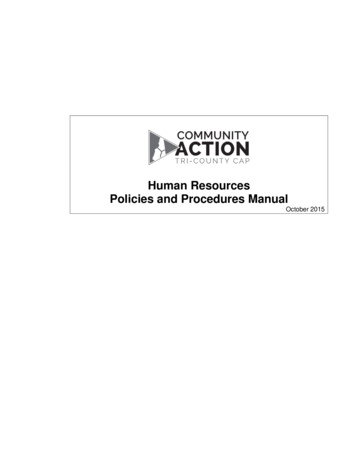
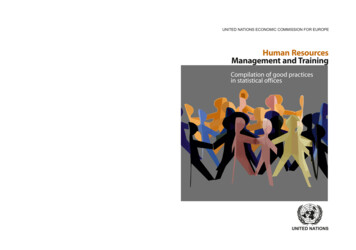

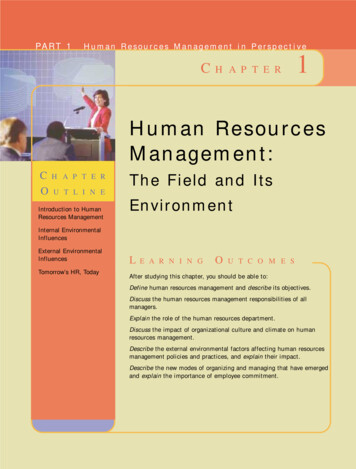
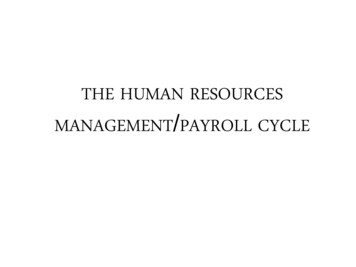
![[IV‐ADV‐9‐A] Tips and Tricks for Payroll and Human Resources](/img/9/tips-and-tricks-payroll-and-hr.jpg)
